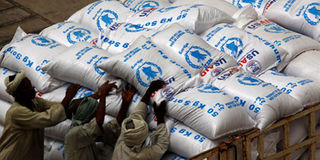Conflict, high prices mean millions still hungry in South Sudan

South Sudanese offload food aid from the World Food Programme (WFP).
What you need to know:
- Although the total number of people suffering severe shortages is predicted to fall to 4.8 million from a peak of 6 million in June, those affected are in a worse condition with the number classified as living "in emergency" - one level below famine - having doubled since last year.
- Hyperinflation also plays a role with the price of food staples increasing by hundreds of percent.
Devastating food shortages and high prices continue to affect nearly half the people in South Sudan and aid agencies warned on Monday that some regions could again slide into famine.
Nearly five million people lack adequate food, said the United Nations' World Food Programme (WFP) and Food and Agriculture Organization (FAO), blaming destruction and economic collapse caused by a civil war since late 2013.
"The country's greenbelt has been ravaged by fighting and finding a peaceful solution to this man-made tragedy should be the top priority or the situation will get even worse next year," said Serge Tissot of the FAO in a joint statement.
In February this year, famine was declared in some rebel-held parts of the country but emergency food deliveries and air drops - although hampered by the government - meant that by June experts said the famine had subsided.
Monday's report shows how precarious that respite is.
"A massive humanitarian response helped stop famine in parts of the country this year," said Adnan Khan of WFP.
"It is chilling to see that in a worst-case scenario, similar conditions could appear in multiple places in 2018," he said.
The word "famine" is used according to a scientific system agreed upon by global agencies, with hunger classified on a scale of one to five, with five denoting famine and humanitarian catastrophe.
The statement signed by FAO, WFP and the UN children's agency (UNICEF) instead refers to 25,000 people living in "famine-like conditions" in areas where "insecurity has heavily constrained the livelihood activities and humanitarian assistance."
Hyperinflation also plays a role with the price of food staples increasing by hundreds of percent.
Although the total number of people suffering severe shortages is predicted to fall to 4.8 million from a peak of 6 million in June, those affected are in a worse condition with the number classified as living "in emergency" - one level below famine - having doubled since last year.
The conflict that pitted President Salva Kiir against his former deputy Riek Machar before spreading across the country has also forced two million South Sudanese to flee their country for safety abroad.




